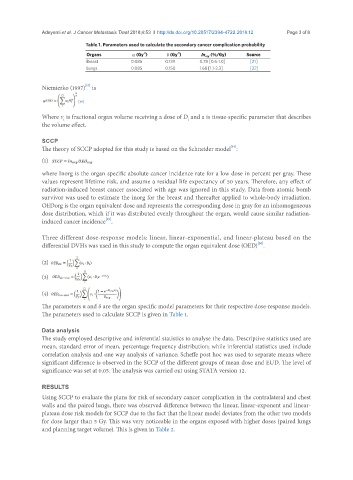Page 632 - Read Online
P. 632
Adeyemi et al. J Cancer Metastasis Treat 2018;4:53 I http://dx.doi.org/10.20517/2394-4722.2018.12 Page 3 of 8
Table 1. Parameters used to calculate the secondary cancer complication probability
-1
-1
Organs α (Gy ) δ (Gy ) In org (%/Gy) Source
Breast 0.085 0.139 0.78 [0.6-1.0] [21]
Lungs 0.085 0.150 1.68 [1.1-2.3] [22]
[17]
Niemierko (1997) is
[18]
Where v is fractional organ volume receiving a dose of D and a is tissue-specific parameter that describes
i
i
the volume effect.
SCCP
[19]
The theory of SCCP adopted for this study is based on the Schneider model :
(1)
where Inorg is the organ specific absolute cancer incidence rate for a low dose in percent per gray. These
values represent lifetime risk, and assume a residual life expectancy of 50 years. Therefore, any effect of
radiation-induced breast cancer associated with age was ignored in this study. Data from atomic bomb
survivor was used to estimate the inorg for the breast and thereafter applied to whole-body irradiation.
OEDorg is the organ equivalent dose and represents the corresponding dose in gray for an inhomogeneous
dose distribution, which if it was distributed evenly throughout the organ, would cause similar radiation-
[19]
induced cancer incidence .
Three different dose-response models: linear, linear-exponential, and linear-plateau based on the
[20]
differential DVHs was used in this study to compute the organ equivalent dose (OED) .
(2)
(3)
(4)
The parameters α and δ are the organ specific model parameters for their respective dose-response models.
The parameters used to calculate SCCP is given in Table 1.
Data analysis
The study employed descriptive and inferential statistics to analyse the data. Descriptive statistics used are
mean, standard error of mean, percentage frequency distribution; while inferential statistics used include
correlation analysis and one way analysis of variance; Scheffe post hoc was used to separate means where
significant difference is observed in the SCCP of the different groups of mean dose and EUD. The level of
significance was set at 0.05. The analysis was carried out using STATA version 12.
RESULTS
Using SCCP to evaluate the plans for risk of secondary cancer complication in the contralateral and chest
walls and the paired lungs, there was observed difference between the linear, linear-exponent and linear-
plateau dose risk models for SCCP due to the fact that the linear model deviates from the other two models
for dose larger than 5 Gy. This was very noticeable in the organs exposed with higher doses (paired lungs
and planning target volume). This is given in Table 2.

